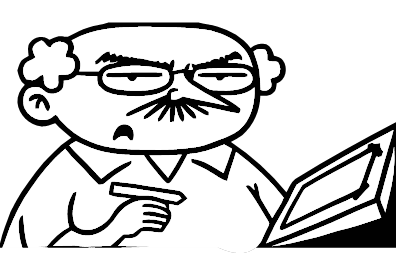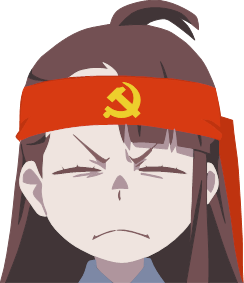The Sleep State
E: (This is just the name for energy saving mode of all the old liches in office right now)
The Sleep State
E: (This is just the name for energy saving mode of all the old liches in office right now)

I hope you are doing well i haven’t been on the tube in a while



PresidentSleeper 

bump amber whataboutism


Among posters, SorosFootSoldier, Among steeds, Red Hare


i mean, Aria of Sorrow was poggers though
[i think this a shop though, but it’s too funny to think that Prigo was big on LNs, though i fully believe that it wasn’t a SAM launched but it was Megumin casting Explosion on the plane fuselage]



warbly George Lucas voice: “It’s like poetry, they rhyme.”


The ruler who relies on friendship and support from distant countries, makes light of his relations with close neighbours, counts on the aid from big powers, and provokes surrounding countries, is liable to ruin.
-Han Fei, Portents Of Ruin ( The Complete Works of Han Fei Tzu Vol. I, trans. by Arthur Probsthain)




This goes way too hard as an emoji and as a generated prompt, thank you!


welcome friend, we are glad to have you! 
Commenting now to find this post easier, bumping for visibility, and will edit after reading, sorry about missing the previous post, Othello, entered a depressive spiral and just bounced back a few days ago, looking forward to this week’s discussion!


It’s pog, and many people are saying this, how many games can you blow away a outhouse and the pixelated guy inside falls in the ordure pit (with the little flush string)? Not many!

Sure thing friend, please stay safe 
- What is the weakness of spontaneity?
Put most elegantly by Fanon: “Tactics are mistaken for strategy.” As previously described with the lumpenproletariat, the spontaneous eruption of resistance within the cities may change the nature of the national struggle as forces of coercion in the form of colonial military forces or colonial police focused on cracking down on dissent in rural districts are forced to retreat to the cities (regions where compradors and colonial administration are centered) to restore the order of colonial rule, yet Fanon states that this is not enough:
“They [leaders of popular revolts] discover that the success of the struggle presupposes clear objectives, a definite methodology and above all the need for the mass of the people to realize that their unorganized efforts can only be a temporary dynamic. You can hold out for three days—maybe even for three months—on the strength of the admixture of sheer resentment contained in the mass of the people; but you won’t win a national war, you’ll never overthrow the terrible enemy machine, and you won’t change human beings if you forget to raise the standard of consciousness of the rank-and-file.” [Emphases mine.]
This gets back to Fanon writing that decolonization is a act that dismantles the material and ideology structures of the colonizers. One cannot rely solely on spontaneous reaction to the atrocities of the colonizing force (though their atrocities are many) to push the colonized into opposing the colonizers, because colonizers has in the past, and will, recruit among the compradors and opportunist lumpenproletariat to tamp down on anti-colonial movements.
Decolonization requires political education of the masses, (“the political education of the masses is seen to be a historic necessity”), of self-critique and improvement on past shortcomings to improve in future programs and decision-making (“The leaders show their power and authority by criticizing mistakes, using every appraisal of past conduct to bring the lesson home, and thus insure fresh conditions for progress,”) and it requires the an organizational framework to facilitate the transmission of shared experiences and understandings, directing mass action, and establish communicative ties of solidarity between colonized people of all backgrounds in opposition to colonialism:
"All this taking stock of the situation, this enlightening of consciousness, and this advance in the knowledge of the history of societies are only possible within the frame work of an organization, and inside the structure of a people [emphasis mine]. Such an organization is set afoot by the use of revolutionary elements coming from the towns at the beginning of the rising, together with those rebels who go down into the country as the fight goes on. It is this core which constitutes the embryonic political organization of the rebellion. But on the other hand the peasants, who are all the time adding to their knowledge in the light of experience, will come to show themselves capable of directing the people’s struggle. Between the nation on a wartime footing and its leaders there is established a mutual current of enlightenment and enrichment. "
 A really great chapter, and while I’d like to answer the other questions, my understanding of every point Fanon is making for this chapter is from cursory reading and I don’t feel confident enough to answer some of the other questions for fear of completely misconstruing the points of the chapter (hopefully I didn’t misconstrue his points or miss context from some of the things I took away from the questions I did answer.) Fanon’s analysis on the lumpenproletariat in a exploited colonial/neocolonial society is really interesting and from some of the theory that I have read, lines up with Mao’s 1926 Analysis of the Classes in Chinese Society as a class of revolutionary potential but with caveats: “Apart from all these, there is the fairly large lumpen-proletariat, made up of peasants who have lost their land and handicraftsmen who cannot get work. They lead the most precarious existence of all. […] One of China’s difficult problems is how to handle these people. Brave fighters but apt to be destructive, they can become a revolutionary force if given proper guidance.” I haven’t read much theory but the analyses of the lumpenproletariats and discussions on their revolutionary potential are always interesting, especially if Mao in the previous quote is like ‘uh we’re still going over our approach with the lumpen, everybody.’
A really great chapter, and while I’d like to answer the other questions, my understanding of every point Fanon is making for this chapter is from cursory reading and I don’t feel confident enough to answer some of the other questions for fear of completely misconstruing the points of the chapter (hopefully I didn’t misconstrue his points or miss context from some of the things I took away from the questions I did answer.) Fanon’s analysis on the lumpenproletariat in a exploited colonial/neocolonial society is really interesting and from some of the theory that I have read, lines up with Mao’s 1926 Analysis of the Classes in Chinese Society as a class of revolutionary potential but with caveats: “Apart from all these, there is the fairly large lumpen-proletariat, made up of peasants who have lost their land and handicraftsmen who cannot get work. They lead the most precarious existence of all. […] One of China’s difficult problems is how to handle these people. Brave fighters but apt to be destructive, they can become a revolutionary force if given proper guidance.” I haven’t read much theory but the analyses of the lumpenproletariats and discussions on their revolutionary potential are always interesting, especially if Mao in the previous quote is like ‘uh we’re still going over our approach with the lumpen, everybody.’
I spent a good bit of time reading the chapters (I missed the ping when this was first posted, sorry Othello) and it kept me way into the night and a bit in the morning so I hope this discussion response wasn’t better in my mind than posted. The analyses of class in any theory always pulls my interest and Fanon’s viewpoint of class structures within the framework of a colonial/neocolonial society is a new perspective to add to my existing understandings of class. Overall a great chapter, but one that I need to read over again (and with an exhaustion-free brain) to fully understand Fanon’s points. Thanks again Othello, looking forward to the discussion for this chapter from others, and with future chapter discussions!
(Apparently Hexbear is not happy with my post in 1 block so I had to split it up into 2 posts)
Another Wretched of the Earth Chapter Discussion  This one is my favorite so far (which I’ll get into in at the end.) Again my breadth of analysis is a bit limited as a first-time read but here are some of my understandings based on a few of the discussion questions. All quotes have been taken from the Farrington translation of Fanon’s Wretched of the Earth
This one is my favorite so far (which I’ll get into in at the end.) Again my breadth of analysis is a bit limited as a first-time read but here are some of my understandings based on a few of the discussion questions. All quotes have been taken from the Farrington translation of Fanon’s Wretched of the Earth
- Who is the lumpenproletariat? Why are the essential to a revolution, why is discounting their potential a mistake?
The Lumpenproletariat, writes Fanon, are composed of the dispossessed masses of growing rural populations, with either no physical holdings, or social ties of their own, or those who are affected by policies of colonial expropriation, and who exist within the periphery in urban centers, most often in conditions of poverty (“…that fraction of the peasant population which is blocked on the outer fringe of the urban centers, that fraction which has not yet succeeded in finding a bone to gnaw in the colonial system.”) who Fanon writes constitutes the “urban spearhead” of rebellion against colonialism. “For the lumpenproletariat, that horde of starving men, uprooted from their tribe and from their clan, constitutes one of the most spontaneous and the most radically revolutionary forces of a colonized people.”
In what ways is the lumpenproletariat so critical as to revolution? First, as Fanon writes: “The constitution of a lumpenproletariat is a phenomenon which obeys its own logic, and neither the brimming activity of the missionaries nor the decrees of the central government can check its growth.” I think here the key word that Fanon uses here is growth. Perhaps I’m reading a bit too much from just a single word, but my understanding of land dispossession, resource expropriation, and the associating rising poverty and social alienation that follows said policies by compradors of colonial rule, are social issues that increase in both intensity and popular discontent, with a continued colonialist or neocolonialist administration.
Fanon also writes, the lumpenproletariat are a class that is unafraid of violence and action. “These classless idlers will by militant and decisive action discover the path that leads to nationhood. They won’t become reformed characters to please colonial society, fitting in with the morality of its rulers; quite on the contrary, they take for granted the impossibility of their entering the city save by hand grenades and revolvers.” Harkening back the the first chapter, “decolonization is always a violent phenomenon,” and the lumpenproletariat, a dispossessed class, one socially alienated from the colonial governance that they are subject to, and one that is unafraid of violence, and who, as a growing class exists at the edges of urban society constitute a potentially revolutionary portion of the urban population that plays a key role in social movements in opposition to colonial/neocolonial administration:
“The outbreak of the rebellion in the towns changes the nature of the struggle. Whereas before the colonialist troops were entirely concerned with the country districts, we now see them falling back in haste on the towns in order to ensure the safety of the town population and their property. The forces of repression spread out; danger is present everywhere; now it’s the very soil of the nation, the whole of the colony, which goes into a trance. The armed groups of peasants look on while the mailed fist loses its grip. The rising in the towns is like an unhoped-for gas balloon.”
On the other hand, why is brushing aside the lumpenproletariat as a class significant to an urban portion of resistance to colonialism or neocolonialism? Fanon writes that if the movement for national liberation does not reach out to the lumpenproletariat, than the foreign colonialists will (" If this available reserve of human effort is not immediately organized by the forces of rebellion, it will find itself fighting as hired soldiers side by side with the colonial troops.") He cites the recruitment of lumpenproletariats in social and military roles aiding foreign powers: by the French in Algeria, by the Portuguese in Angola, and by the Belgians in the presence of lumpenproletariat in mass-meetings in opposition to Prime Minister Patrice Lumumba in the former Republic of the Congo (now the Democratic Republic of the Congo.) Fanon writes of the tenacity of the colonizers in exploiting intranational and regional conflicts to divide popular discontent in order to quash it and that they too see the potential of the lumpenproletariat as tools of violence that can be directed toward a resisting colony:
“The enemy is aware of ideological weaknesses, for he analyzes the forces of rebellion and studies more and more carefully the aggregate enemy which makes up a colonial people; he is also aware of the spiritual instability of certain layers of the population. The enemy discovers the existence, side by side with the disciplined and well-organized advance guard of rebellion, of a mass of men whose participation is constantly at the mercy of their being for too long accustomed to physiological wretchedness, humiliation, and irresponsibility. The enemy is ready to pay a high price for the services of this mass.”
- Who are the urban proletariat? what kind of positions do they have? why do they represent the “bourgeoisie fraction of the colonized population”?
Fanon writes that the urban proletariat as a class within a colonized state differs in comparison the the urban proletariat within the Western capitalist state. Specifically, Fanon writes that the small, growing urban proletariat (described within the text as “embryonic”) are key members within the colonized populace that allows the administration by colonizers to function smoothly, and that within the colonized population, they are a class “which has been most pampered by the colonial regime” as potential compradors. Some of the roles that this urban proletariat include key occupations that allow for resource extraction and expropriation (in text examples of “dockers,” “miners”) occupations that maintains the functioning infrastructure within these urban centers ( in text as “tram conductors” “taxi drivers” “nurses”) as well as occupations that directly deal with the colonialists themselves (in text as “interpreters.”) The urban proletariat within a colonized nation, as the beneficiaries of the scraps given by foreign corporations and colonizing governments, are the ones most amenable Western ideology: “Their way of thinking is already marked in many points by the comparatively well-to-do class, distinguished by technical advances, that they spring from. Here ‘modern ideas’ reign.”
The rural populace is distrustful of the urban proletariat, writes Fanon: they think of the urban proletariat as without morals, who adopts Europeans conventions, their ideology, their clothing, their language, as traitors to national heritage and values and who get along with occupying powers and make do within the framework of a colonial system. Fanon writes that this is not the classic rural-urban divide, that colonialism creates a new tension: “Here, we are not dealing with the old antagonism between town and country; it is the antagonism which exists between the native who is excluded from the advantages of colonialism and his counterpart who manages to turn colonial exploitation to his account.” This tension is not lost on colonizing powers, who seeks to make use of this conflict to further divide the rural and urban population to quash resistance to colonial rule.
“People say to me, you are- you really are the Tathagata, the thus gone one, and i have to say, they’re right folks. I’ve awoken, i seen many many things, i really have, i see the world yatha-bhutam, as it is folks, and samsara, the cycle of existence? it’s done for alongside that nasty dukkha. the noble eightfold path, it’s wonderful, the best path, the only path, don’t let them fool you. Cravings? Gone - the nasty Mara doesn’t want you to know this - we love the cessation of dukkha and the ending of samsara through moksha, it’s wonderful folks, it’s the best”